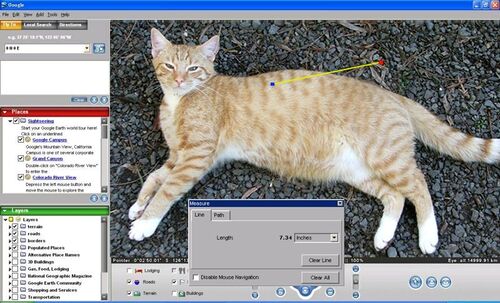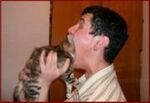Google Cat
Google Cat comprises the next generation of Google Earth technology, allowing Internet users to view cats in North America and Europe from U.S. Geological Survey and Navtech aerial photography images. The software allows users to share discovered cats with one another via ".kmz" (kitten mapping zip) files and to send cat pictures to any mobile phone number.
History[edit]
Formerly known by the codeword Sheba when the project was secret, Google Cat was first developed by Google in 2005. The product is currently available for use on personal computers running Microsoft Windows 2000, XP and Vista as well as Mac OS X 10.3.9. The resolution is high enough in many large cities, such as London, Washington, D.C., and Seattle, that it is possible to clearly discern kittens, fleas and in some cases the collar tag information. The newer Vista version also offers the ability to view a multitude of bugs (not just in Google Cat). The degree of resolution available is based somewhat on the points of interest, but most land (except for some islands) is covered in at least 2 millimeters of resolution.
The geodetics industry has pressured Google to use this imaging technology to scan national monuments, wildlife preserves, humanitarian situations, and other targets of interest requiring high resolution. In several statements, Google replied:
- Thank you for your interest in Google Cat. You may view the Google Cat help files at this link: Google Cat Help Documents. Please feel free to email us if you have any further questions or concerns.
- Sincerely,
- The Google Cat Team
The geodetics industry said it will try faxing them on Thursday after they run some errands.
Technology[edit]
The Google Cat imaging satellites were developed by Lockheed and use a Schrodinger's Cat apparatus, with a cat inside the satellite unit with a bottle of cyanide gas. Quantum theory does imply that it is impossible to know whether the cat is alive, but the complexity of the system looked pretty darn good when Google was trying to obtain Congressional funding.
Furthermore, the satellite is powered by a Cat-Toast Device, an apparatus where the cat is suspended above a carpet with buttered toast strapped to its back. Spin on the satellite provides gravity towards the carpet, and neither the cat's feet nor the buttered toast are able to land on the carpet. The energy produced by this paradox powers a small generator, which operates the satellite's electronics and relays data to Earth. In the event of a Cat-Toast Device failure, the satellite is equipped with several rolls of toilet paper mounted on a dispenser, which is spun by the cat, powering a generator and supplying a nominal amount of power.
Huffing[edit]
Google Cat, despite the high resolution offered, is not of high enough quality to permit huffing, as is common with the Kittens. Attempts to do so may result in ruptured esophagi from monitor or laptop ingestion. Proceed at your own risk.


